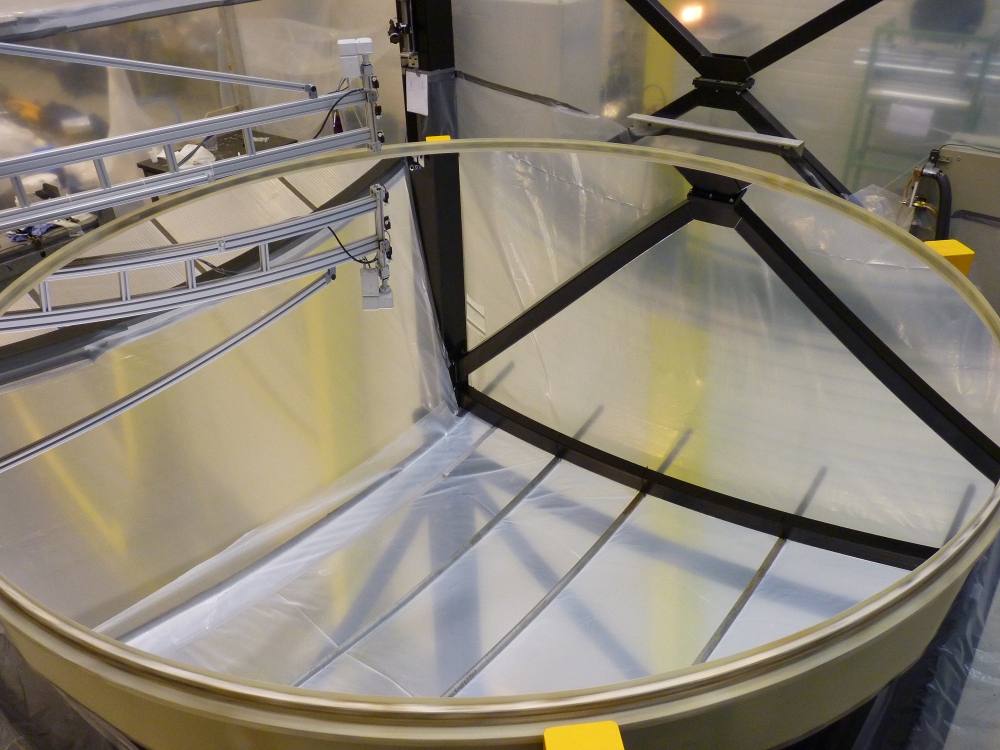Indian, UBC astronomers celebrate first light at liquid-mirror telescope
June 8, 2022

June 8, 2022

Telescope locations are often remote, but Dr. Paul Hickson’s work on the newly commissioned International Liquid Mirror Telescope (ILMT) in the central Himalayas involved quite an impressive trek.
“Going there was a bit of an adventure,” admits Dr. Hickson, a pioneer in liquid mirror technology and astronomer with UBC Physics and Astronomy. “I’d fly to Delhi airport, and then there’s a 10-hour taxi ride, first through Delhi and then across the plains of northern India and then up through the mountains.”
The ILMT—located at Devasthal Peak at 2,450 metres altitude in the central Himalayan range—houses a four-metre rotating mirror coated with a thin film of liquid mercury.
“Rotating once every eight seconds, the mirror floats on a film of compressed air about 10 microns thick,” explains Dr. Hickson. “By way of comparison, a human hair is approximately 70 microns thick. The air bearings are so sensitive that even smoke particles can damage them. A second air cushion prevents the rotor from moving sideways.”
Liquid-mirror telescopes take advantage of the fact that the surface of a rotating liquid naturally takes on a parabolic shape, which is ideal for focusing light. The telescope is designed to survey the strip of sky passing overhead each night, allowing it to identify transient or variable objects such as supernovae, gravitational lenses, space debris and asteroids.
Dr. Hickson had perfected liquid-mirror technology over the years while developing the Large Zenith Telescope at UBC’s Malcom Knapp Research Forest east of Vancouver, B.C.—at that point the largest liquid-metal mirror ever built. So his lab was able to apply that knowledge to the design of the ILMT air system.
A major benefit of the collaboration is that Professor Hickson and his students will have full access to the data recorded by the ILMT, which will be in operation from approximately October to June each year when it will shut down during India’s monsoon season.
“When regular science operations begin later this year, the ILMT will produce about 10 GB of data every night, which will be quickly analyzed to reveal variable and transient stellar sources,” said Dr. Brajesh Kumar, ILMT project scientist at ARIES. The 3.6-meter Devasthal Optical Telescope located nearby, with the availability of sophisticated spectroscopic instruments, will allow rapid follow-up observations of newly detected transient sources with the ILMT.
“The collected data will be ideally suited to perform a deep photometric and astrometric variability survey over a period of typically five years,” notes project director Professor Jean Surdej, University of Liège, Belgium and University of Poznan, Poland.
Liquid mercury provides a low-cost alternative to conventional glass mirrors. A thin transparent film of optical-quality mylar protects the mercury from wind and stops any small waves on the surface caused by the rotation. The mylar is so thin that it's comparable to the wavelength of light and therefore does not distort the telescope’s images.
The reflected light passes through a sophisticated multi-lens optical corrector that produces sharp images over a wide field of view. A large-format electronic camera, located at the focus, records the images.
“The rotation of the Earth causes the images to drift across the camera, but this motion is compensated electronically says Hickson. “The camera has a corrector lens that was specially designed to remove star trail curvature. Stars go in circles around the north celestial pole, around the North Star. If you take a time exposure, the stars don't go in straight lines, they go in arcs or circles. But this corrector is designed to correct for that to remove the curvature to straighten out the star trails, giving us sharp images.”
The ILMT collaboration includes researchers at the Aryabhatta Research Institute of Observational Sciences, and the Indian Space Research Organization, the University of Liège and the Royal Observatory of Belgium in Belgium, Poznan Observatory in Poland, the Ulugh Beg Astronomical Institute of the Uzbek Academy of Sciences and National University of Uzbekistan in Uzbekistan, the University of British Columbia, Laval University, the University of Montreal, the University of Toronto, York University and the University of Victoria in Canada.
The telescope was designed and built by the Advanced Mechanical and Optical Systems and the Centre Spatial de Liège in Belgium.
We honour xwməθkwəy̓ əm (Musqueam) on whose ancestral, unceded territory UBC Vancouver is situated. UBC Science is committed to building meaningful relationships with Indigenous peoples so we can advance Reconciliation and ensure traditional ways of knowing enrich our teaching and research.
Learn more: Musqueam First Nation